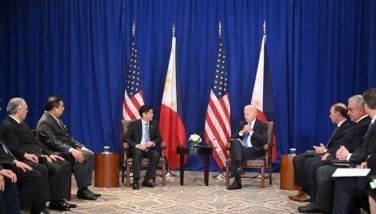Arroyo orders study of training PAF pilots to address commercial shortage
March 28, 2006 | 12:00am
President Arroyo asked the Clark Development Council (CDC) to look into the possibility of training Air Force pilots to fly commercial jets as a stop-gap measure to address the shortage of commercial pilots in the country.
Mrs. Arroyo issued the directive yesterday during a televised roundtable discussion with officials led by CDC president Antonio Ng, Subic Bay Metropolitan Authority (SBMA) chairman Feliciano Salonga, SBMA administrator Armand Arreza, and Subic-Clark Development Council Eduardo Pamintuan.
Ng announced the Clark Institute of Aviation, an P850-million venture of British Group and Prescient, a sister company of Singapore Technologies, would be opening in May to accept students for training as fully-certified Airbus pilots.
"The airlines have the airplanes but have no pilots, and the Air Force have pilots but no airplanes. I would say if possible, in coordination with the aviation school and private airlines, we would look for a way for Air Force pilots to be trained in commercial airlines," Mrs. Arroyo said during the televised meeting in Malacañang.
After the show, Ng admitted the directive would not be easy to implement since Air Force pilots are banned from moonlighting as commercial pilots.
The directive could run counter to a recent Air Force directive to reinforce existing regulations to prevent their pilots from immediately leaving the service to join the more lucrative commercial airlines, he said.
Officials stressed the directive is meant to prevent some pilots from using the Air Force as a "stepping stone" to enter the more lucrative commercial sector without having to pay for expensive aviation and flying schools.
It was not clear whether the Palace would allow active duty Air Force pilots to fly commercial jets or if public funds would be used to pay for the expensive training.
"We have to sit down with the Air Force to study whether this would be feasible," Ng said.
"It’s just a stop-gap (move) that addresses some of the airline pilot needs," he said.
Ng said the aviation institute could accommodate as many as 400 students once it opens and would be open to all those wishing to enroll. The course lasts one year.
Ng said he also expects many foreigners to enroll in the aviation school. He claimed that in Asia alone, there is a shortage of 4,000 commercial pilots. — Paolo Romero
Mrs. Arroyo issued the directive yesterday during a televised roundtable discussion with officials led by CDC president Antonio Ng, Subic Bay Metropolitan Authority (SBMA) chairman Feliciano Salonga, SBMA administrator Armand Arreza, and Subic-Clark Development Council Eduardo Pamintuan.
Ng announced the Clark Institute of Aviation, an P850-million venture of British Group and Prescient, a sister company of Singapore Technologies, would be opening in May to accept students for training as fully-certified Airbus pilots.
"The airlines have the airplanes but have no pilots, and the Air Force have pilots but no airplanes. I would say if possible, in coordination with the aviation school and private airlines, we would look for a way for Air Force pilots to be trained in commercial airlines," Mrs. Arroyo said during the televised meeting in Malacañang.
After the show, Ng admitted the directive would not be easy to implement since Air Force pilots are banned from moonlighting as commercial pilots.
The directive could run counter to a recent Air Force directive to reinforce existing regulations to prevent their pilots from immediately leaving the service to join the more lucrative commercial airlines, he said.
Officials stressed the directive is meant to prevent some pilots from using the Air Force as a "stepping stone" to enter the more lucrative commercial sector without having to pay for expensive aviation and flying schools.
It was not clear whether the Palace would allow active duty Air Force pilots to fly commercial jets or if public funds would be used to pay for the expensive training.
"We have to sit down with the Air Force to study whether this would be feasible," Ng said.
"It’s just a stop-gap (move) that addresses some of the airline pilot needs," he said.
Ng said the aviation institute could accommodate as many as 400 students once it opens and would be open to all those wishing to enroll. The course lasts one year.
Ng said he also expects many foreigners to enroll in the aviation school. He claimed that in Asia alone, there is a shortage of 4,000 commercial pilots. — Paolo Romero
BrandSpace Articles
<
>
- Latest
- Trending
Trending
Latest
Trending
Latest
Recommended
January 13, 2025 - 12:00am






























